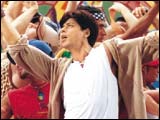The crowds last Thursday evening at the Loewes State Theatre were uncontrollable.
 Men, woman, grandmothers, grandfathers and lots of little children, all gathered in the heart of Manhattan's Times Square to catch the first day show of the latest tearjerker/entertainer offering of what has become a ritual from the Karan Johar factory, Kal Ho Naa Ho.
Men, woman, grandmothers, grandfathers and lots of little children, all gathered in the heart of Manhattan's Times Square to catch the first day show of the latest tearjerker/entertainer offering of what has become a ritual from the Karan Johar factory, Kal Ho Naa Ho.
When ushers started checking the tickets the long line merged together, people at the back began to push ahead and all hell was let loose. People rushed past the helpless ushers, breaking barriers, down the stairs, straight into the theatre.
When all the seats were filled up, there were still 20-odd people standing. Which would mean two things: the theatre had oversold tickets (most unlikely) or some people had managed to get in without buying tickets.
| |||||||||||
By the look of the enthusiasm among New Yorkers for KHNH, two things are clear: most Indians do not eat the traditional turkey meal on Thanksgiving Day (KHNH opened in the US a day earlier so the release could coincide with the Thanksgiving holiday).
Also I can safely predict that the film will become the biggest Bollywood hit of the year in the US, which mostly saw one movie after another being thrown by the wayside.
Two years ago when Johar's Kabhi Khushi Kabhie Gham became a monstrous hit in the US and UK, Sagarika Ghose, an Indian journalist wrote in the Indian Express that most NRIs are living in a world of their own, with no clue about how far India has progressed.
She added Bollywood was 'bound in chains to the dictates of the overseas audiences [the NRIs],' in whose 'cultural imagination, India must remain a vast stretch of villages, fakirs, sadhus and cool spirituality.'
Ghose's conclusion damned all those who have left India and settled in the far reaches of the globe: 'Indian culture itself stands in danger of being colonised by NRIs, precisely because of their power and success.'
Ghose's analysis annoyed me. Blame Indians who live abroad for the weepy, overtly sentimental, and socially retrogressive work that Bollywood dream-makers continue to churn out, with hopes of recouping their expenses and profits abroad.
And one more thing. Ghose refers to us -- people of Indian origin living abroad as NRIs -- a term coined in India to define the rich successful Indians in the UK and the US, with the hope they would reinvest their foreign-earned wealth in India.
In reality we are part of the Indian Diaspora, creating our own Indian identity outside India. We are cab drivers, restaurant workers, teachers, Silicon Valley moguls, writers, filmmakers, doctors, lawyers, community activists, gays and lesbians, and battered women, living our own lives in adopted lands.
Only few of us have plans of returning back home.
 There is a big difference between the two expressions: NRIs and those living in the Indian Diaspora. It is an issue of the state of mind, but Ghose does not seem to get it.
There is a big difference between the two expressions: NRIs and those living in the Indian Diaspora. It is an issue of the state of mind, but Ghose does not seem to get it.
The looming box-office bonanza for the makers of KHNH, especially from the overseas markets, will no doubt create further attacks from a small group of intelligentsia in India.
Those idiotic NRIs only think India is a land of Gita-thumping mothers, the articles will possibly suggest, even though to be slightly original, Johar and his director Nikhil Advani have come up with one Guru Granth Sahib-thumping grandmother and a Bible-thumping mother.
Give those NRIs images of New York City and/or a Jana Gana Mana singing child and they will arrive in droves and spend their hard-earned dollars at the box-office, which will eventually be repatriated to India.
Meanwhile, the poor Indians are starving for good culture, never mind the higher aesthetic quality and artistic beauty of the countless saas-bahu soap operas that clutter the landscape of Indian television!
There is a lot good with KHNH. With sharp editing, split-screen images and a quick paced screenplay, at least in the first third of the movie, technically the movie is far superior to what Bollywood has produced in several years.
Some of the songs are a treat to watch as are the actors. And New York City has never looked more beautiful.
But the film is mostly flawed. First, the issue of logistics: Why would a woman (Preity Zinta's character) who lives in Queens go jogging all the way to Central Park (unless she is preparing for the New York City marathon)? And if she tells her mother (played by Jaya Bachchan) that she has gone to Central Park, what was she doing also jogging in downtown Manhattan, around the Tribeca area and South Street Seaport? Where does she go in the ferry -- from Queens to where?
If this woman lives in Queens, how come each time she is unhappy, she turns up under the Brooklyn Bridge to look over the vast expanse of downtown Manhattan? How does her mother (who also lives in Queens) suddenly walk up to the Brooklyn Bridge to find her daughter, considering there are way too many subway and bus lines to connect the two points.
And if her mother runs a neighbourhood diner, how come that establishment is located near Duane and Reade streets, again in the Tribeca neighbourhood?
The crime of mixing New York City's boroughs is a bad crime to be committed by Johar, Advani and company.
KHNH commits other crimes too. Johar has talked about spending a long time in New York observing how people move around and walk in the city. He captures a certain pace of the life, people picking up coffee at Starbucks, eating at fine restaurants and rushing to work (although I have never seen a desi singing songs in Central Park and on the Brooklyn Bridge).
But Johar and Advani's observation of Indians in New York and their mindset remains superficial, at best. There is no deeper understanding of what motivates these people or what drives them each day.
Instead, the filmmakers have carefully captured Bollywood's one-dimensional characters and placed them in New York City.
Most characters in the movie, especially the supporting cast, remain caricatures. From the bhajan singing friends of the grandmother, to the boy-hungry, overweight neighbourhood Indian girl and her over-the top sex-starved sister, to the desi deejay, who speaks with the most peculiar accent and the video-pirate-turned-potential-suitor.
The inner homes, the bedrooms and the living rooms in the film (other than Saif Ali Khan's upscale trendy apartment with a balcony overlooking the East River), whether in Queens or the suburbs of Connecticut, reek of Bollywoodised lives of the middle and the upper classes.
Then there are political and social problems with the film. There are countless jokes against homosexuals, which worked real well with the audience. That Bollywood has started to accept the existence of homosexuality is a move forward, but the mindless jokes take the issue several steps back right into the closet.
Then there is a more serious issue: a subplot about an adopted girl (subjected to the most crass and hurtful abuses from her Punjabi grandmother), is resolved only when it is revealed that she is the illegitimate child of the man of the household.
What are Johar and Advani saying here? It is okay to adopt children if there is a family blood link, but not okay otherwise?
Very few seemed concerned about these and other issues that bothered me.
Ghose and her supporters will surely say that the NRIs are culturally and intellectually inferior to accept this form of mindless and retrogressive work. But who is to blame for the failure of Bollywood to produce good quality, entertaining and reality based cinema? Indians living abroad, who these days rarely step into movie theatres to see new films from India (unless it is a big production like Lagaan, K3G, Devdas or Kaante) or filmmakers themselves who seem incapable of taking the risk and straying away from the time-and-again proven formula for success?
 So here is a message to Johar, Advani, and the Chopras of Bollywood: give us decent entertainment, but do not take us for granted.
So here is a message to Johar, Advani, and the Chopras of Bollywood: give us decent entertainment, but do not take us for granted.
Remember what happened to Subhash Ghai when he openly announced that his movies were meant for Indians living in the Diaspora? His preachy, over-the-top and often ridiculous Yaadein had a strong opening, but the movie collapsed in the following week.
Now, it is a painful distant memory.





